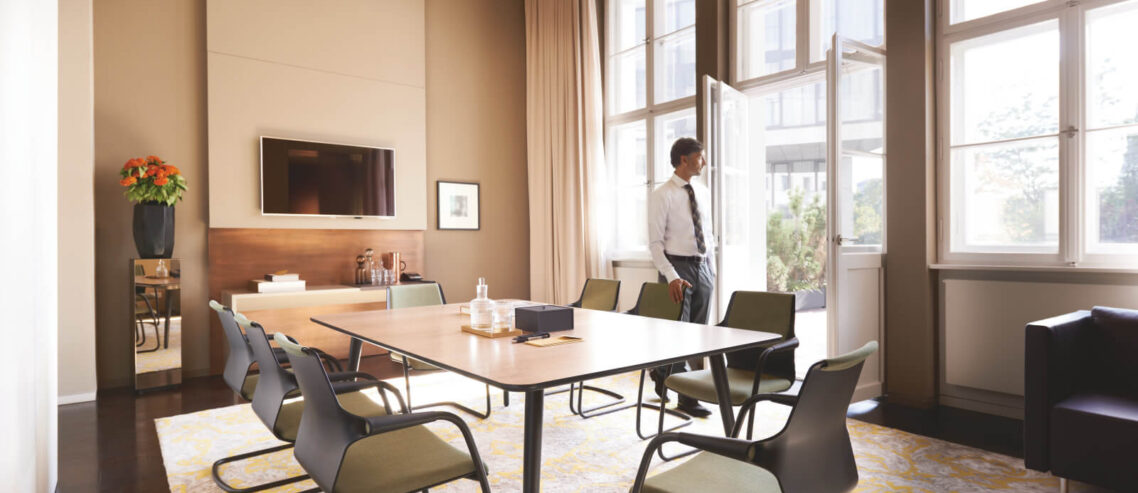How Meeting Room Furniture Helps Productive Collaboration
Meeting rooms are the heartbeat of the modern office. They are places where every company member can conveniently collaborate, share ideas, and reinforce the company culture.
Consequently, meeting room furniture is an often-overlooked, yet critical element of fostering a productive meeting. We will dive into the details of these multi-functional spaces and how the right meeting room furniture can be a game-changer.
Why do you need a meeting room?
For many of us, our living rooms became makeshift virtual meeting rooms in 2020. Even so, the demand for meeting rooms and meeting room furniture in workplaces continues to increase.¹ Even with a hybrid work model, nothing can replace meeting rooms as places to develop ideas, innovation, and shared company culture.
Privacy
In the office, you have likely needed to discuss a confidential topic away from prying eyes and ears. A well-designed meeting room is a perfect solution to keeping information on a need-to-know basis. The use of a meeting room also can minimize distractions for other workers who need quiet office environments outside the meeting room.
Productivity
Meeting rooms provide an escape from a cluttered desk or co-working area. You can concentrate on pointed topics, presentations, or ideas in these rooms without distractions. Initial Hygiene UK discovered that 57% of employees surveyed feel more motivated and have greater morale when their workplace is clean.²A meeting space, by nature, is a place for motivation and productivity in a group setting. You will often find them clear of any clutter or noise that would hinder productivity for those in the meeting.
Convenience
When you must search for the right place to meet, your momentum is slowed. A meeting room and its respective meeting room furniture can provide a quick, simple, and convenient solution to communicate effectively.
Space
With the onset of the pandemic, we began to use our spaces differently, both in our personal and professional lives. Out of necessity, our home offices, living room, bedrooms, and kitchens became our virtual conference rooms. But well-crafted, intentional space set aside for in-person discussions can be much more effective than a virtual zoom meeting.
You can better communicate with a clearer tone, intent, body language, and visual aids in a real-life meeting space. You can also avoid those pesky challenges and hiccups that come with technology. These include unstable connections, attendees on mute or not turning on their cameras, or any variety of technological glitches. Face-to-face communication is the best and clearest way to communicate with a team effectively.
How should a meeting room be furnished?
Not every company will have the same needs when it comes to meeting room furniture. A company that produces gaming tech is going to have different conference room furniture than a law office. However, you will notice some similar aspects in any given meeting space.
Meeting rooms: Also called conference rooms, these types of spaces should be furnished to suit many purposes. They should be available for anyone to reserve for collaboration with other team members, clients, or customers. They should have meeting room tables surrounded by chairs or alternative meeting room seating. That way, attendees can effectively communicate and see anything presented.
Some companies need more flexibility than others when it comes to meeting rooms. For example, suppose you have a large company that employs dozens of workers in one office. In that case, your meeting room may need to have stackable seating appropriate for presentations and seminar-style discussions.
Some companies that meet to spur creativity equip meeting rooms with whiteboards, smartboards, large notepads, or other brainstorming tools. These informal spaces can also be more relaxed, with distinctive styles of seating, office tables, and breakout areas.
Boardroom furniture: These spaces are typically more formal. Here, you will meet with board members, office executives, and the “higher-ups” of a company. You may see microphones, video screens or laptop docking stations built into boardroom tables to accommodate members’ needs. You will often find executive chairs as the preferred seating in a boardroom. They are built not only for luxury and style but also to keep attendees comfortable throughout long meetings.
How to improve a meeting room
To put it simply: the key to a great meeting room is choosing the right office furniture. But before you start shopping for conference tables, ask some questions about the space. What types of meetings are happening in the room? Will this be primarily a place to talk to new clients, brainstorm ideas, or share company updates?
Talk to other people who work at the company who will be using the meeting room most often. They will have the best insight into their needs regarding meeting tables, seating, amenities, colours, and style.
As you pick between colours, styles, and sizes for office meeting furniture, remember that each aspect conveys a message. A round table may communicate a team atmosphere where everyone is equal. A large, rectangular table may convey the message that there is a definite chain of command.
The use of colour is also a powerful way to improve a meeting room with minimal effort. Collaborative and agile working spaces generally use brighter, more vibrant colours to inject energy and creativity. In contrast, areas for concentrated working opt might benefit from softer, more-muted tones like blue and purple.
Choosing the right meeting room furniture
When it comes to meeting room furniture, Sedus has a wide range of office meeting tables, chairs, and solutions to suit your company’s needs. Check out our award-winning products and resources so your company can start using collaborative spaces to their full potential.
1 Meeting rooms are in demand as more folks return to the workplace
